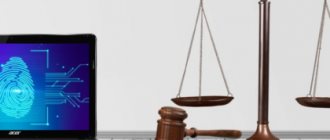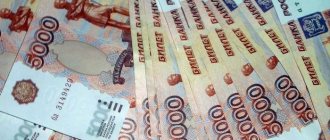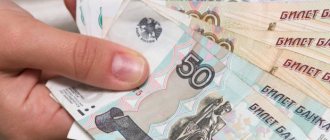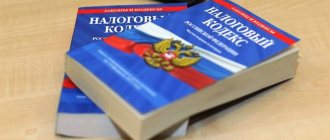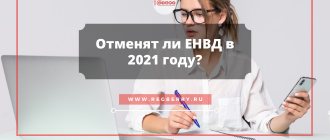A company or individual entrepreneur, if they pay VAT, can, as they say, deduct “input” VAT. The “input” tax is the VAT that is included in the price of purchased goods, works or services. However, sometimes it is necessary to restore the “input” VAT accepted for deduction, that is, pay it to the budget. It turns out that the restoration of VAT leads to an increase in the tax payable, and the restored VAT is the money by which the VAT will increase, which must be paid to the budget.
If, when purchasing goods, works, VAT was absent (for example, due to the purchase of goods from a simplifier) or was not accepted for deduction (for example, due to the absence of an invoice), then there cannot be an obligation to restore VAT.
If the activity is exempt from tax
VAT is restored in the quarter in which the listed property is transferred or begins to be used for the specified operations.
The company must restore the tax in the amount in which it was previously accepted for deduction (except for the restoration of VAT on fixed assets and intangible assets - in this case it is restored in proportion to their residual value).
A reversal entry is made in accounting:
DEBIT 68 CREDIT 19
– VAT has been restored.
Recovered VAT amounts should be taken into account as part of the company's other expenses.
EXAMPLE 1
Medservice LLC provides consulting and medical services.
The company pays VAT at a rate of 18% on the sale of consulting services, and medical services are exempt from this tax (clause 2 of Article 149 of the Tax Code of the Russian Federation). In the first quarter, the company bought stationery in the amount of 35,400 rubles. (including VAT - 5400 rubles). The company's accountant made the following entries: DEBIT 60 CREDIT 51 – 35,400 rubles. – paid for stationery; DEBIT 10 CREDIT 60 – 30,000 rub. – stationery received; DEBIT 19 CREDIT 60 – 5400 rub. – VAT allocated; DEBIT 68 subaccount “Calculations for VAT” CREDIT 19 – 5400 rub. – VAT is accepted for deduction.
In the second quarter, some stationery worth 20,000 rubles.
was written off to a department that provides consulting services. At the same time, the following posting was made: DEBIT 20 subaccount “Consulting services” CREDIT 10 - 20,000 rubles. – stationery items are written off.
The rest of the stationery in the amount of 10,000 rubles.
entered the department providing medical services. VAT related to these stationery products is in the amount of RUB 1,800. (RUB 10,000 × 18%) needs to be restored in the second quarter. The postings should be as follows: DEBIT 68 subaccount “VAT Calculations” CREDIT 19 – 1800 rubles. – VAT on stationery used in the provision of medical services has been restored; DEBIT 91 CREDIT 19 – 1800 rub. – VAT is written off for other expenses.
What will happen to VAT for charity?
Any organization, including a commercial one, can engage in charity. The Ministry of Finance of the Russian Federation clarifies that the legislation does not impose a ban on private companies in terms of providing gratuitous assistance (letter of the Ministry of Finance of the Russian Federation dated June 30, 2004 No. 26-12/43525).
Input VAT on property that is transferred to charity or used to perform work (provide services) for charitable purposes is not deductible and is taken into account in the cost of the transferred property (work, services) (letter of the Ministry of Finance dated May 10, 2012 No. 03-07-07 /49).
You can find more complete information on the topic in ConsultantPlus. Free trial access to the system for 2 days.
Switching to special mode
If a company (entrepreneur) switches to UTII, simplified taxation system (STS) or patent taxation system (PTS) (this applies only to entrepreneurs), then VAT should be restored in the quarter that precedes the transition.
For fixed assets and intangible assets, you must restore VAT in proportion to its residual value (excluding revaluations).
EXAMPLE 2
In the third quarter, Passive LLC purchased a computer worth 35,400 rubles.
(including VAT - 5400 rubles). In the same quarter, Passive paid for the computer and put it into operation in September. The service life of the computer is three years. The company accepted “input” VAT on the computer for deduction. In the third quarter, “Passive” paid and capitalized office supplies in the amount of 11,800 rubles. (including VAT - 1800 rubles). The company also deducted the amount of VAT on office supplies. However, by the end of December, the stationery remained in the company's warehouse. From January 1 next year, Passive switched to a simplified taxation system. The Liability accountant must make the following entries: in the third quarter DEBIT 08 CREDIT 60 - 30,000 rubles. – the computer has been capitalized; DEBIT 19 CREDIT 60 – 5400 rub. – VAT on the computer has been taken into account; DEBIT 60 CREDIT 51 – 35,400 rub. – paid for the computer; DEBIT 01 CREDIT 08 – 30,000 rub. – the computer is put into operation; DEBIT 68 subaccount “Calculations for VAT” CREDIT 19 – 5400 rub. – accepted for deduction of VAT on the computer; DEBIT 10 CREDIT 60 – 10,000 rub. – stationery has been received; DEBIT 19 CREDIT 60 – 1800 rub. – VAT on stationery is taken into account; DEBIT 68 subaccount “Calculations for VAT” CREDIT 19 – 1800 rub. – VAT on office supplies is accepted for deduction; DEBIT 60 CREDIT 51 – 11,800 rub. – paid for stationery.
in the fourth quarter
DEBIT 20 (26, 44) CREDIT 02 – 2500 rub. (RUB 30,000: 3: 12 × 3 months) – depreciation was accrued on the computer in October – December; DEBIT 68 subaccount “Calculations for VAT” CREDIT 19 – 1800 rub. – VAT on stationery has been restored; DEBIT 91 CREDIT 19 – 1800 rub. – VAT on stationery is included in other expenses; DEBIT 68 subaccount “Calculations for VAT” CREDIT 19 – 4950 rub. ((30,000 rub. − 2,500 rub.) × 18%) – VAT attributable to the residual value of the computer has been restored; DEBIT 91 CREDIT 19 – 4950 rub. – VAT on the computer is included in other expenses.
note
VAT does not need to be restored when switching to a single agricultural tax.
How to take into account VAT on OSN with UTII?
If a company uses these two tax regimes, it is necessary to keep separate VAT records. Incoming goods for both types of activities are accounted for differently. In this case, when developing an accounting policy, the company must take into account the need for a quarterly calculation of VAT with the determination of the proportion for each type of taxation, so that this calculation allows for reliable data on VAT deductions.
Let's consider several options for distributing inventory items by type of activity:
- Incoming goods may clearly relate to one of the activities due to the cyclical nature of procurement (for example, monthly). In this case, if materials are purchased for activities under the OSN, then the entire VAT on the received goods is deducted, and the invoice is recorded in the purchase book. If the purchased goods are intended for activities under UTII, then VAT is fully included in the cost of materials, and the invoice is not registered.
- When purchasing materials with their simultaneous use for 2 types of activities, part of the materials is subject to deduction, and part is subject to VAT restoration. Separate accounting is already needed here. If it is not maintained, then an updated VAT return must be submitted to the Federal Tax Service (letter of the Ministry of Finance dated December 6, 2006 No. 03-04-15/214). According to this clarification, VAT amounts accepted for deduction in a larger volume can be restored in the quarter when the goods were used for activities under UTII.
- If at the beginning of the period it is not possible to determine in what type of activity the material will be used, then it is necessary to determine its actual use at the end of the quarter. At the same time, the VAT amounts for each type of activity are determined.
Transfer of property
VAT previously accepted for deduction must also be restored if the taxpayer transfers property (intangible assets, property rights) as (clause 1, clause 3, article 170 of the Tax Code of the Russian Federation):
- contribution to the authorized (share) capital of business companies and partnerships;
- contribution under an investment partnership agreement;
- share contributions to mutual funds of cooperatives;
- replenishment of the target capital of a non-profit organization.
For goods, materials, etc., the tax is restored in full. For fixed assets and intangible assets - in an amount proportional to their residual (book) value (excluding revaluation).
In this case, the amount of the restored tax must be indicated in the documents used to formalize the transfer of property (intangible assets, property rights). This amount is subject to tax deduction from the receiving company after the property is accepted for accounting. The only condition: this property must be used for transactions subject to VAT.
What actions should the company's management take to maintain separate VAT accounting?
Art. 170 of the Tax Code of the Russian Federation does not decipher the methodology and list of measures for organizing separate accounting. Companies themselves must take care of their development and registration in accounting policies. All recommendations of the chief accountant should be communicated to employees. It is worth understanding that violating the accepted procedure can lead to problems and even fines.
There are several options for separate VAT accounting:
- use of subaccounts to account 19;
- posting of goods according to VAT taxation groups.
It is highly advisable to use subaccounts for VAT account 19, which can be used to reflect data on various VAT transactions, including those with different rates. The lack of high-quality accounting does not allow deducting and including VAT in expenses to calculate profits.
To distribute VAT on taxable and non-taxable transactions, the proportion is calculated based on the cost of goods shipped for the quarter or year. Usually the previous period is taken as a basis, since the current period may not have complete cost data.
The development of provisions for separate accounting in a company should be based on primary documents (for example, invoices), orders regarding the attribution of specific goods to one or another type of taxation (Resolution of the Federal Antimonopoly Service of the Ural District dated August 25, 2008 No. Ф09-5940/08-С2 ).
Read about the methodology for maintaining separate VAT accounting in the article “How to maintain separate VAT accounting (principles and methods)?” .
See also “Recovery of VAT amounts for periods without separate accounting.”
Other recovery cases
VAT should be restored in several more cases.
1.
If a company has transferred an advance to the seller, it can deduct the VAT paid as part of the advance. At the time of shipment and receipt of an invoice from the seller, the company deducts VAT on the purchased goods. And VAT, offset when paying the advance, is restored.
Please note: from October 1, 2014, a rule has been in force according to which the amounts of VAT accepted for deduction in relation to the advance payment should be restored in the amount related to the goods shipped (work performed, services rendered, transferred property rights), in payment of which the amounts are subject to offset advance That is, if the seller shipped the goods for an amount less than the advance received, the buyer is obliged to recover VAT only in the amount indicated on the shipment invoice.
2.
If the company transferred an advance to the supplier, accepted VAT for deduction, and then terminated the contract (and the seller returned the advance), then the tax should also be restored. In addition, VAT, according to the Ministry of Finance, will have to be restored even if the customer writes off the receivables in the form of an advance paid to the contractor for work not completed by him (letter of the Ministry of Finance of the Russian Federation dated January 23, 2015 No. 03-07- 11/69652, dated April 11, 2014 No. 03-07-11/16527).
3.
If after the purchase the cost of purchased goods (works, services) has decreased, then VAT must be restored in the amount of the difference between the tax amounts on the cost of purchased goods before and after the reduction. In this case, VAT is restored during the period of receipt of either primary documents for changes in the cost of purchased goods or an adjustment invoice (depending on what happened earlier).
4.
If a company is provided with subsidies from the federal budget to reimburse the costs of paying for purchased goods (work, services), including tax, as well as to reimburse the costs of paying tax upon import, then VAT is restored during the period of provision of subsidies.
5.
If the company began to use the purchased (built) property in operations not subject to VAT, then the tax is restored within 10 years, starting from the year in which the accrual of tax depreciation began.
A similar rule applies to reconstructed (modernized) real estate properties. In this case, VAT is restored for 10 years, starting from the year in which tax depreciation began to be calculated on the changed value of the object.
note
From January 1, 2015, the norm on the restoration of VAT on goods (works, services) that are used in transactions at a rate of 0% was excluded from the Tax Code (clause 5, clause 3, article 170 of the Tax Code of the Russian Federation).
This norm ordered taxpayers to restore previously deductible VAT in the event of further use of goods (work, services) in sales operations subject to VAT at a zero rate in accordance with paragraph 1 of Article 164 of the Tax Code. The tax had to be restored in the period in which the goods were shipped (work performed, services provided). Let us recall that in this norm, among the operations taxed at a zero VAT rate, the sale of goods for export, services for the international transportation of goods, work (services) for the processing of goods placed under the customs procedure of processing on the customs territory, services for the provision of railway rolling stock are named and (or) containers, as well as transport and forwarding services, services for transporting passengers and luggage, etc.
What is said in paragraph 4 of Art. 170 of the Tax Code of the Russian Federation?
In paragraph 4 of Art. 170 of the Tax Code of the Russian Federation deals with the issues of assigning VAT to one or another category, which depends on the type of VAT taxation applied.
Thus, this norm provides for the following operations:
- free from VAT - the tax is included in the price (clause 2 of Article 170 of the Tax Code of the Russian Federation);
- subject to VAT - a deduction is applied (Article 172);
- combined - VAT categories are used in proportion depending on the scheme recorded by the company in the accounting policy, which must take into account the provisions of clause 4.1.
A company will not be able to deduct tax and include it in expenses if it is not accounted for by taxation categories (letter of the Ministry of Finance dated November 11, 2009 No. 03-07-11/296). A company may not divide VAT into categories if transactions that do not include VAT amount to 5% of the total amount of its expenses (Letter of the Ministry of Finance dated December 29, 2008 No. 03-07-11/387). Then the entire tax is deductible (Article 172 of the Tax Code of the Russian Federation).
To ensure comparability of indicators, VAT should be excluded from them. The procedure for calculating expenses under the Tax Code of the Russian Federation is not given, so the company needs to include in its accounting policy a provision on assessing expenses and calculating 5%.
Read about separate accounting in the article “The Ministry of Finance has clarified how to calculate the proportion for separate accounting of “input” VAT .

